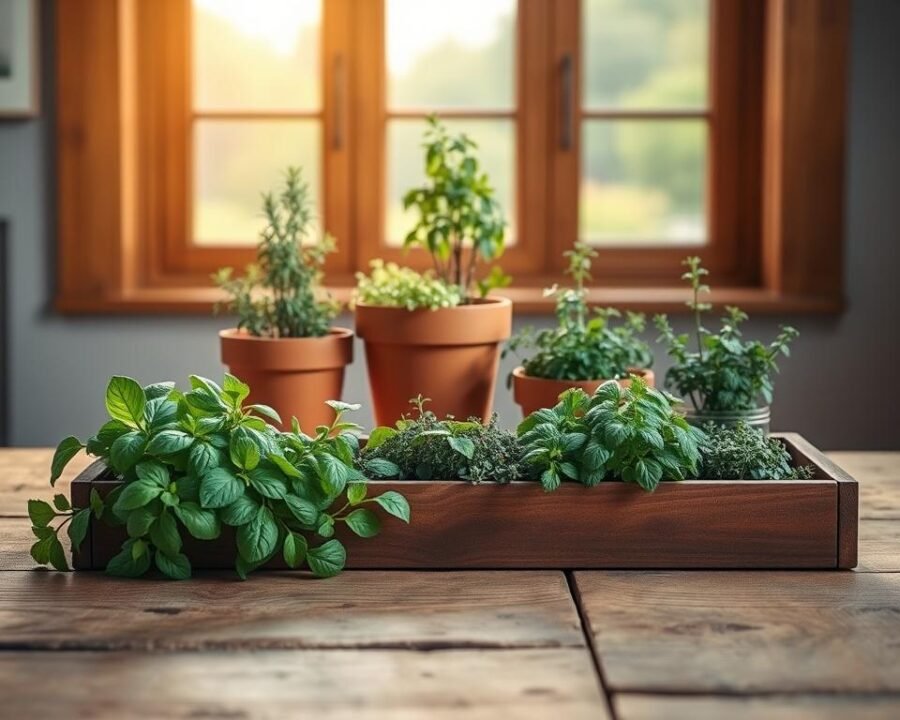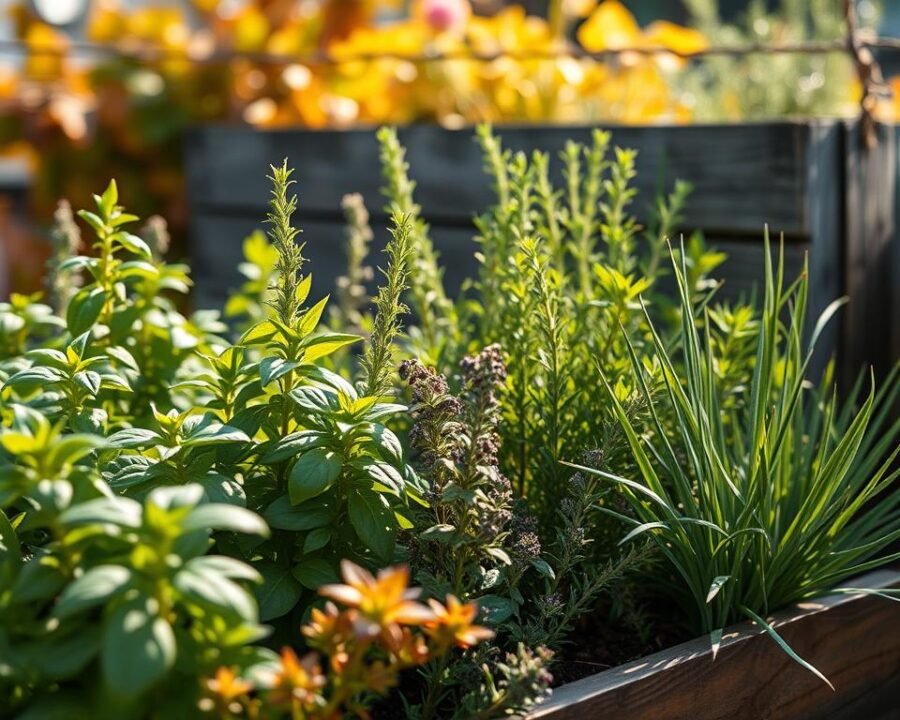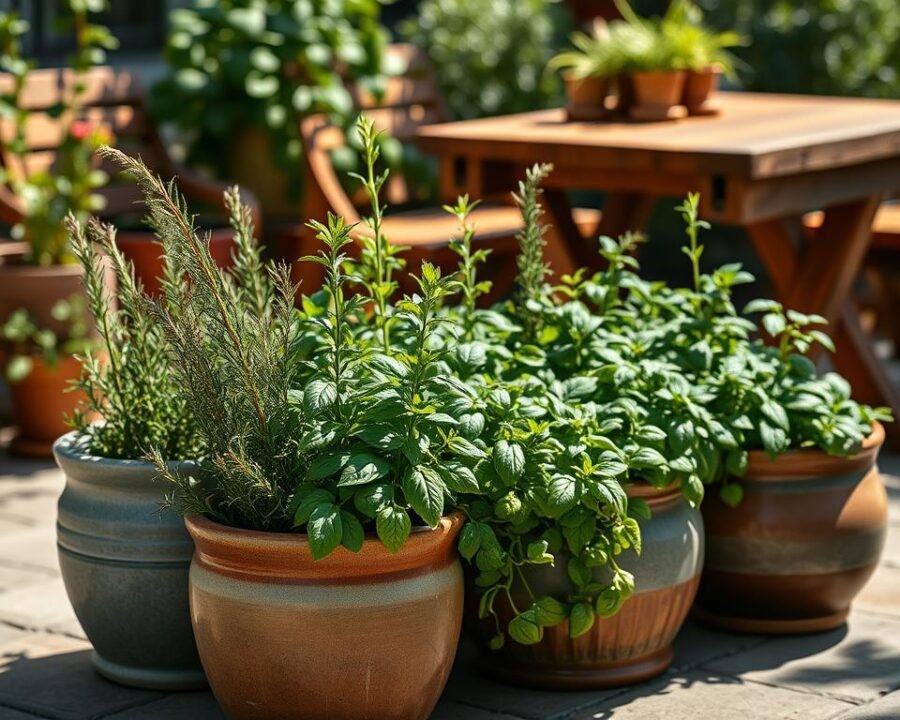There’s something magical about plucking fresh herbs right from your windowsill. The aroma of basil, the crispness of chives—each leaf carries the promise of vibrant flavors and wellness. Whether you live in a cozy apartment or a house with limited outdoor space, cultivating a herb garden is simpler than you think.
Urban dwellers are embracing compact container gardening, turning balconies and patios into lush, edible havens. Imagine snipping mint for your morning tea or garnishing dishes with homegrown parsley—no store runs needed. Even beginners can succeed with low-maintenance plants like chives, which thrive with minimal care.
We’re here to guide you through every step, from choosing the right pots to mastering seasonal care. Let’s transform your space into a culinary sanctuary, one herb at a time.
Key Takeaways
- Compact herb gardens work perfectly in small spaces like apartments.
- Fresh herbs enhance meals and offer health benefits year-round.
- Beginner-friendly options like chives require little maintenance.
- Balconies and windowsills can support thriving edible gardens.
- Harvesting homegrown herbs saves money and elevates cooking.
Why Herb Planters Are the Perfect Starter Garden
Urban spaces transform into lush gardens with compact herb planters. Unlike traditional plots, these systems fit balconies and windowsills, making fresh flavors accessible year-round. A $3 supermarket basil bunch costs just $0.10 when homegrown—savings add up fast.
According to USDA data, container gardening surged by 63% since 2018. Families report cutting grocery bills by 15% while enjoying aromatic, decorative, and culinary perks. Controlled conditions also minimize pests—no chemicals needed.
Fast-growing herbs like basil and mint thrive even in partial shade. This debunks the myth that herbs need full sun. For quick results, focus on these top performers:
| Herb | Days to Harvest | Ideal Planter Size |
|---|---|---|
| Basil | 30–40 | 8–12 inches |
| Cilantro | 45–55 | 6–8 inches |
| Dill | 40–50 | 10–12 inches |
Bonus: Many herbs naturally repel mosquitoes. Plant mint near seating areas for a fragrant, bug-free summer. With the right setup, your kitchen stays stocked with vibrant flavors.
How to Grow Herb Planter Everyone Is Using: Getting Started
Fresh flavors begin with smart choices. Selecting the right combination of plants, containers, and soil creates the foundation for a thriving mini-garden. Let’s break down each element for guaranteed success.
Choosing the Right Herbs for Your Planter
Not all herbs are created equal. Beginners should start with forgiving varieties like mint or chives, while rosemary suits experienced gardeners. Avoid big-box store plants—they often carry synthetic fungicides.
For organic results, try Baker Creek or High Mowing seeds. These brands offer untreated, non-GMO options perfect for culinary use. Companion planting boosts growth—basil loves tomatoes, while chives protect carrots.
Natural pest control comes free with these plants:
- Lavender – repels moths and fleas
- Lemongrass – deters mosquitoes
- Thyme – keeps cabbage worms away
Picking the Ideal Container
Drainage matters most. Look for containers with holes at the bottom to prevent root rot. Terra cotta pots breathe better than plastic, reducing disease risks.
Size depends on the herb’s growth habit:
| Herb Type | Minimum Depth | Recommended Material |
|---|---|---|
| Annuals (basil, cilantro) | 12 inches | Clay |
| Perennials (rosemary, thyme) | 16 inches | Glazed ceramic |
Selecting the Best Soil Mix
Standard potting mix won’t cut it. Herbs need a blend of ¾ garden soil and ¼ compost for nutrients. Avoid mixes labeled for flowers—they retain too much water.
For container gardening success, check out our patio herb guide for more pro tips.
Setting Up Your Herb Planter for Success
A well-prepared herb planter ensures robust growth and bountiful harvests. Whether you’re transplanting seedlings or sowing seeds, proper setup prevents common pitfalls like overcrowding or poor drainage. Let’s dive into the essentials.

Step-by-Step Planting Guide
Start with the right conditions. Most plants thrive at 55–70°F—avoid frosty windowsills. Gently loosen the root ball before placing it in the pot to encourage spreading.
Spacing matters. Overpacking stifles growth. Follow this guideline for mixed planters:
- Basil: 6–8 inches apart
- Parsley: 4–6 inches apart
- Thyme: 3–4 inches apart
Patience pays off. Germination times vary:
| Herb | Germination Time |
|---|---|
| Basil | 5–10 days |
| Cilantro | 7–14 days |
Placement for Optimal Sunlight
Sunlight exposure varies by herb. South-facing windows deliver 6+ hours of light—ideal for rosemary. East-facing spots suit shade-tolerant mint.
Rotate pots weekly for even growth. No sunny spot? LED grow lights work wonders. Just keep them 6 inches above the plants.
Check for holes at the bottom of containers. Elevate pots with saucers to prevent waterlogging. Your garden will thank you.
Daily Care for Thriving Herbs
Healthy herbs start with consistent care and attention. A little effort each day ensures robust growth and flavorful leaves. Whether you’re nurturing basil or mint, these practices keep your plants vibrant.

Watering Do’s and Don’ts
Check soil moisture daily. The finger test—inserting a finger up to the second knuckle—beats most meters for accuracy. If it feels dry, it’s time to hydrate.
Try bottom-watering for deep roots. Place your container in a tray of water for 10 minutes. This prevents leaf rot and encourages stronger growth.
Avoid these overwatering signs:
- Yellowing leaves
- White mold on soil
- Musty odor from the container
| Herb Type | Water Needs | Best Time to Water |
|---|---|---|
| Mint | Keep moist | Early morning |
| Rosemary | Let dry slightly | Late afternoon |
Pruning and Harvesting Tips
Snip herbs regularly to promote bushier growth. Always cut above a leaf node—this way, new stems sprout faster. Morning harvests lock in the best flavor.
For mint, trim ⅓ of the stems weekly. Basil thrives when you pinch off flower buds. Share extras with neighbors or dry them for winter use.
Pro tip: Set up a rainwater barrel. Free, chlorine-free water keeps plants happiest.
Seasonal Adjustments for Year-Round Growth
Seasonal shifts bring new challenges and opportunities for your green companions. With simple tweaks, your garden stays productive through scorching summers and chilly winters. Let’s explore the best way to maintain vibrant flavors all year.

Summer Care Strategies
Heat waves demand quick action. Shield plants with shade cloth during peak sunlight hours. Increase watering frequency—containers dry out faster in 90°F+ conditions.
Drought-resistant varieties thrive when others wilt. Focus on these resilient choices:
- Thyme – thrives in dry soil
- Oregano – loves heat and neglect
- Sage – recovers quickly from dehydration
Natural pest sprays keep bugs at bay. Mix 1 tsp neem oil with water in a spray bottle. Apply weekly to deter aphids.
Winterizing Your Herb Planter
Frost kills tender roots. Before temperatures drop, move pots home to a sunny windowsill. Insulate outdoor planters with burlap wraps.
Indoor winter care differs by zone:
| Zone | Action |
|---|---|
| 5–6 | Use grow lights for 12+ hours daily |
| 7–9 | Mulch heavily for ground insulation |
Trim leggy stems to encourage bushier growth. Your herbs need less water indoors—overwatering invites mold.
Troubleshooting Common Herb Planter Issues
Even the healthiest plants face challenges. Recognizing early signs of trouble keeps your garden thriving. From pesky insects to mysterious leaf spots, we’ll help you diagnose and fix common problems.
Pests and Diseases to Watch For
Tiny invaders can wreak havoc. Aphids cluster under leaves, while spider mites leave fine webs. Whiteflies swarm when disturbed—catch them early with yellow sticky traps.
Natural solutions work wonders:
- Mix 1 tbsp dish soap with 1 quart water for aphids
- Wipe leaves with rubbing alcohol for mites
- Spray neem oil weekly as prevention
Fungal issues like powdery mildew appear as white dust. Improve airflow and avoid wetting leaves when watering. For severe cases, try this remedy:
| Problem | Solution |
|---|---|
| Root rot | Repot with fresh soil and cinnamon |
| Yellow leaves | Check drainage or add nitrogen-rich fertilizer |
Reviving Unhappy Herbs
Wilting rosemary or pale basil often needs simple adjustments. First, check the soil—soggy roots suffocate, while bone-dry dirt starves plants.
Quick revival tips:
- Trim dead stems to redirect energy
- Move containers to brighter spots if leggy
- Rotate pots for even sun exposure
Hardy varieties like sage and thyme bounce back fastest. For transplants, keep them in shade for two days before full sun. With patience, most plants recover beautifully.
Conclusion: Your Lush Herb Garden Awaits
Transforming your space into a vibrant herb garden brings joy and flavor to daily life. From those first sprouts to hearty harvests, each step builds confidence in gardening. Soon, you’ll enjoy fresh herbs without store runs.
Share your progress with #MyHerbJourney and connect with fellow enthusiasts. For ongoing success, grab our free care calendar—it simplifies seasonal tasks. Dreaming bigger? Explore hydroponic systems for next-level indoor growing.
Your first homemade pesto is closer than you think. Start today with these simple actions:
- Choose one sunny spot for your container
- Pick two favorite herbs to begin
- Water when soil feels dry to the touch
We celebrate your journey toward sustainable, flavorful living. Every snip of homegrown basil makes life richer. Happy planting!
